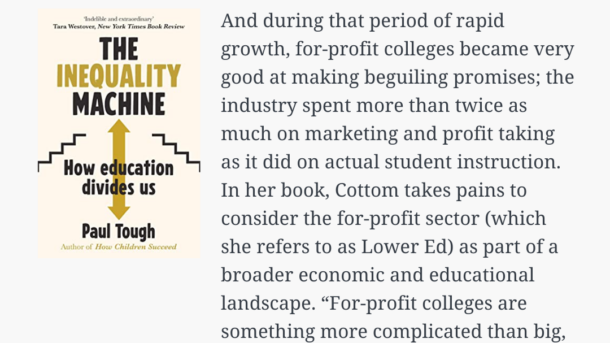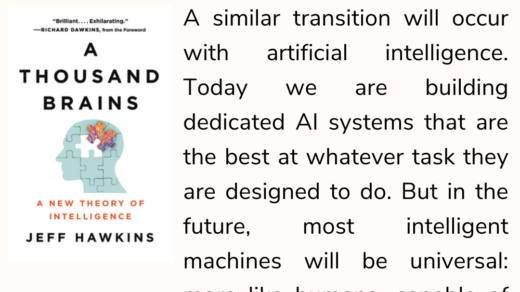In 2017 a sociologist at Virginia Commonwealth University named Tressie McMillan Cottom published a book titled Lower Ed that helps to illuminate the choices facing Orry and Taslim and Alicia and millions of others like them. The book’s nominal subject is the business of for-profit colleges, a sector of the higher education economy that experienced an enormous boom in the first decade of this century, increasing in size from four hundred thousand students in 2000 to two million in 2010, during the same period that so many state governments were making drastic cuts to their higher education budgets. The sector includes everything from strip-mall cosmetology colleges to online PhD programs in business administration at the University of Phoenix, and its remarkable growth came about despite its notoriously poor outcomes for students: high tuition, low graduation rates, and high levels of student debt. In 2012 for-profit colleges were educating just 12 percent of the nation’s college students, but those students accounted for 44 percent of the nation’s student-loan defaults. The question Cottom sets out to answer in her book is: Why? Why would such a manifestly lousy product sell so well? Her answer is that for-profit colleges, during their boom years, figured out how to exploit a new and pervasive gap in the relationship between the education system and the labor marketplace: a job market that demanded more skills, a public education system that didn’t reliably deliver them to the nation’s young people, and a higher education ecosystem that wasn’t equipped or inclined to offer the education and training those young people were being told they needed. In order to make money amid those anxious circumstances, for-profit colleges didn’t need to deliver an actual education; they needed only to deliver the promise of one. And during that period of rapid growth, for-profit colleges became very good at making beguiling promises; the industry spent more than twice as much on marketing and profit taking as it did on actual student instruction. In her book, Cottom takes pains to consider the for-profit sector (which she refers to as Lower Ed) as part of a broader economic and educational landscape. “For-profit colleges are something more complicated than big, evil con artists,” Cottom writes. “They are an indicator of social and economic inequalities and, at the same time, are perpetuators of those inequalities … The growth and stability of Lower Ed is an indication that the private sector has shifted the cost of job training to workers, and the public sector has not provided a social policy response.” At the opposite end of the prestige spectrum from Lower Ed is, of course, Higher Ed: selective institutions like Princeton University and Trinity College and the University of Texas. Our instinct, often, is to consider those elite institutions as part of an entirely separate sphere from the world of Lower Ed. Cottom encourages us to think of them as two sides of the same coin. “Lower Ed can exist precisely because elite Higher Ed does,” she writes. “The latter legitimizes the education gospel while the former absorbs all manner of vulnerable groups who believe in it: single mothers, downsized workers, veterans, people of color, and people transitioning from welfare to work.”
What drives the huge demand for private colleges? It is stated that most for-profit colleges allocate far more resources to marketing their classes than actually improving their product, the classroom experience. It also reminds me of a previous book that I have covered (The Case Against Education), where the main idea was that the main value education provides to us isn’t really about learning, but about signalling.
If we view it from the perspective of people wanting to purchase the perception of having a quality education rather than the actual education itself, then everything makes sense. Regardless of public or private, most colleges would choose to spend tons of money in facilities, marketing and PR to look more legitimate to the public eye. For most of us, not much of the knowledge we learned in our actual university education actually gets used in our careers anyways. The question is whether that spending has gone too far and for me, whether the government should be subsidising those funds that go towards “marketing”.
This pretty much sums up the book on how education eventually becomes a tool that further divides us than a tool of social mobility that we might idealise it to be. More could be done in bridging the information deficit between those who happen to be born into the “right” families. While not intentional, it happens that most resources or new schemes tend to get distributed to those who don’t need it anyways or are the most privileged. From a policy perspective, it then might make sense to dedicate public resources more broadly as most private initiatives tend to already go towards those whom are advantaged already. Proponents of meritocracy might find this a hard pill to swallow, and there indeed.
I’ve been having a few conversations with a few friends recently about our education system, and I hope to have a more in-depth conversation or research on this. What I do find funny, is just realising that as compared to other topics such as say crypto or tech, everyone seems to have very strong opinions about education.



